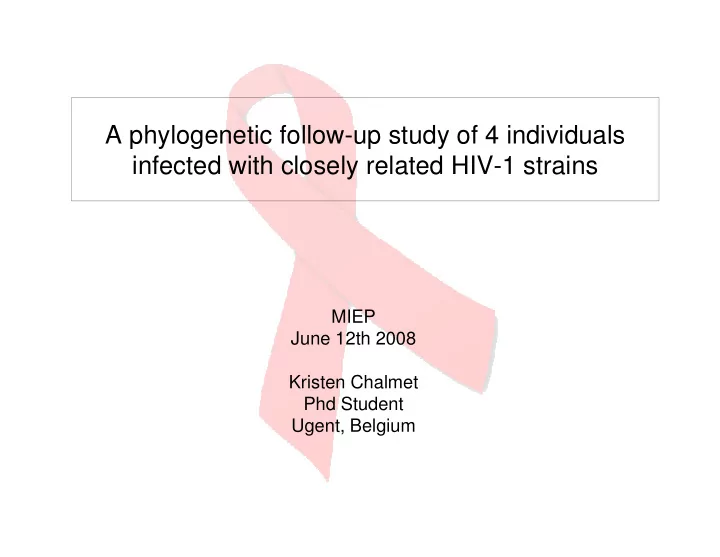

A phylogenetic follow-up study of 4 individuals infected with closely related HIV-1 strains MIEP June 12th 2008 Kristen Chalmet Phd Student Ugent, Belgium
Introduction HIV is the causal agent of AIDS Fig. HIV Medicine 2006, Flying publisher
Introduction Fig Flexner, Nat. Rev. Drug Discov. 2007
Introduction Human Immunodeficiency Virus (HIV-1) infection: � Fast-progressors (FP) (< 2 years) � Slow-progressors (SP) � Non-progressors (NP) ( >15 year) Irrespective of type of transmission/donor Non-progression is result of � Virusrelated factors � Hostrelated factors (eg. � 32 deletion in CCR5 coreceptor gene) Most studies involve NP groups � difficulties: � Diversity between hosts � Diversity between infecting viruses
Introduction HIV-1 shows significant genetic diversity � Between different hosts � Within the same individual � � Primary infection with homogenous population � From then on: evolution to heterogenous population of quasispecies to escape from pressures like immune system or antiretroviral drugs � Most variable region: Env Relation between variability & disease progression is controversial: Less genetic diversity/viral evolution linked with slower progression vs. More genetic diversity/viral evolution linked with slower progression
Set up of this study • ARC Ghent: More than 700 patients being followed � CD4 + en CD8 + T cell counts � Viral load � Sequence analysis of PR and RT ( pol region) • Phylogenetic analysis of pol region reveals relationship between viruses (Hue et al. Aids, 2004; Brenner et al., J.Infect. Dis. 2007) � clusters of patients, infected with closely related viruses � Selection of 4 patients
Phylogenetic tree constructed using heuristic maximum likelihood search � � � � 4 patients infected with almost identical virus (3 transmissions were epidemiologically confirmed) Characteristics: • Patients show significant differences in disease progression • Primary infection with almost identical virus (HIV subtype B) � � viral specific factors 2 patients with � 32 deletion • � � � � Follow-up study of disease progression, viral diversity and viral evolution in env region during 4 years
Materials & Methods • DNA extraction from PBMCs of 4 individuals • Single genome sequencing of env region using limiting dilution • Phylogenetic analysis using Paup*v4.0b10 � Aligment in BioEdit using clustalW with manual correction � Selection of best fitting nucleotide-substituion model according the AIC using Modeltest v3.7 � Construction of phylogenetic trees using Paup*v4.10b10 for a heuristic maximum likelihood search. Bootstrap analysis was performed on 100 replicates.
Results: Confirmation of phylogenetic relationship between 4 individuals using env region of virus of primary infection (outgroup is subtype A infected individual)
Results: Follow-up of disease progression through viral load and CD4+ T Cell counts
Results: Analysis of intrapatient sequence heterogenity Mean nt Mean pairwise difference b from Patient CCR5 Collection Viral CD4 Mean fragment N a distance d % Day consensus lenght c (range) ID genotype date load count (range) (range) ������� A 04/10/02 0 39000 523 14 4,2 (1-11) 1011 (1011-1011) 0,73 (0,00-1,70) A 05/22/03 402 8820 621 12 5,8 (1-13) 1011 (1008-1011) 0,92 (0,00-1,81) A 04/28/04 738 10700 486 13 9,7(0-17) 1007 ( 993-1011) 1,11 (0,10-2,68) A 09/13/06 1593 1960 345 10 37,4 (16-91) 1016 ( 993-1062) 2,21 (1,01-3,90) wt/wt B 05/10/02 0 424000 259 12 2,2 (0-5) 1011 (1011-1011) 0,34 (0,00-0,80) B 06/20/03 400 >100000 385 10 2,4 (2-4) 1011 (1011-1011) 0,17 (0,00-0,40) B 11/17/03 547 68300 646 10 5,8 (2-9) 1006 ( 999-1011) 0,70 (0,10-1,40) B 05/26/04 736 210000 294 12 12,9 (1-20) 1009 ( 996-1014) 1,18 (0,20-2,02) B 05/03/06 1433 >100000 315 10 74,8 (51-83) 1045 (1026-1053) 3,47 (0,20-6,55) wt/wt C 05/14/02 0 104000 361 13 3,5 (1-7) 1009 (1008-1011) 0,56 (0,20-1,30) C 06/23/03 399 36100 716 10 3,9 (2-9) 1011 (1011-1011) 0,38 (0,00-1,00) C 11/28/03 554 39300 437 14 8,8 (2-13) 1011 (1008-1011) 0,88 (0,00-1,71) C 03/31/04 677 31800 675 13 29,4 (8-47) 1025 (1011-1044) 1,55 (0,69-2,75) C 09/05/06 1551 85100 227 13 87,7 (75-107) 1044 (1032-1065) 2,95 (0,48-6,37) ������� D 05/06/02 0 21700 820 17 1,0 (0-3) 1011 (1011-1011) 0,17 (0,00-0,60) D 07/07/03 421 36100 1290 11 0,6 (0-2) 1011 (1011-1011) 0,11 (0,00-0,30) D 03/26/04 680 1710 1040 16 3,4 (0-8) 1011 (1011-1011) 0,51 (0,00-1,10) D 08/02/04 806 2050 1120 11 7,2 (1-10) 1011 (1011-1014) 0,59 (0,20-1,20) D 07/06/06 1500 1240 969 18 12,1 (0-25) 1011 (1011-1011) 1,37 (0,00-2,71)
Results: Analysis of mean pairwise genetic distance
Results: Analysis of viral evolution
Conclusions • Phylogenetic analysis of viral sequences obtained from 4 individuals infected with an almost identical HIV-1 virus allows us to study � intra-patient viral diversity � Intra-patient viral evolution � Inter-patient differences in viral evolution Trough time � Nearly identical virus shows different genetic evolutionary rates in different hosts � More genetic diversity seems related to faster disease progression � Individuals with � 32-deletion show lower evolution rate and slower disease progression compared to wt individuals
Recommend
More recommend